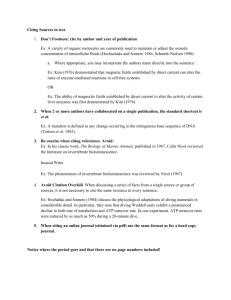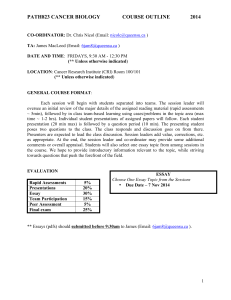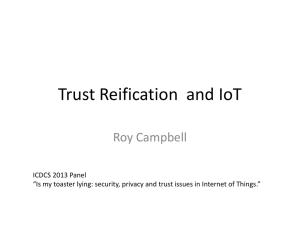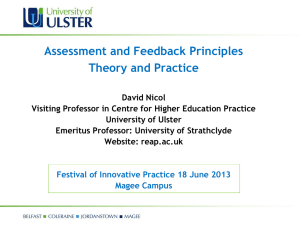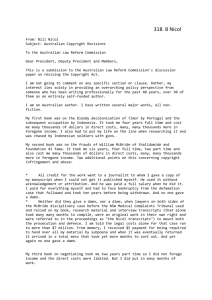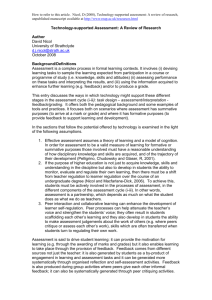Rethinking technology-supported assessment practices in relation to
advertisement
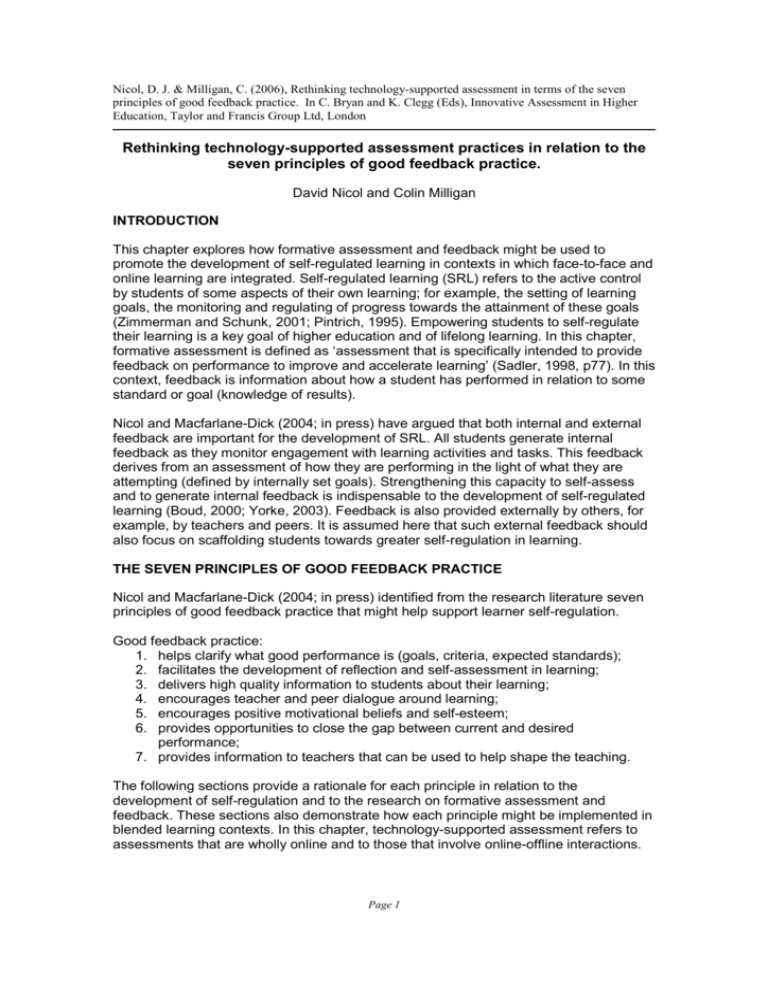
Nicol, D. J. & Milligan, C. (2006), Rethinking technology-supported assessment in terms of the seven principles of good feedback practice. In C. Bryan and K. Clegg (Eds), Innovative Assessment in Higher Education, Taylor and Francis Group Ltd, London Rethinking technology-supported assessment practices in relation to the seven principles of good feedback practice. David Nicol and Colin Milligan INTRODUCTION This chapter explores how formative assessment and feedback might be used to promote the development of self-regulated learning in contexts in which face-to-face and online learning are integrated. Self-regulated learning (SRL) refers to the active control by students of some aspects of their own learning; for example, the setting of learning goals, the monitoring and regulating of progress towards the attainment of these goals (Zimmerman and Schunk, 2001; Pintrich, 1995). Empowering students to self-regulate their learning is a key goal of higher education and of lifelong learning. In this chapter, formative assessment is defined as ‘assessment that is specifically intended to provide feedback on performance to improve and accelerate learning’ (Sadler, 1998, p77). In this context, feedback is information about how a student has performed in relation to some standard or goal (knowledge of results). Nicol and Macfarlane-Dick (2004; in press) have argued that both internal and external feedback are important for the development of SRL. All students generate internal feedback as they monitor engagement with learning activities and tasks. This feedback derives from an assessment of how they are performing in the light of what they are attempting (defined by internally set goals). Strengthening this capacity to self-assess and to generate internal feedback is indispensable to the development of self-regulated learning (Boud, 2000; Yorke, 2003). Feedback is also provided externally by others, for example, by teachers and peers. It is assumed here that such external feedback should also focus on scaffolding students towards greater self-regulation in learning. THE SEVEN PRINCIPLES OF GOOD FEEDBACK PRACTICE Nicol and Macfarlane-Dick (2004; in press) identified from the research literature seven principles of good feedback practice that might help support learner self-regulation. Good feedback practice: 1. helps clarify what good performance is (goals, criteria, expected standards); 2. facilitates the development of reflection and self-assessment in learning; 3. delivers high quality information to students about their learning; 4. encourages teacher and peer dialogue around learning; 5. encourages positive motivational beliefs and self-esteem; 6. provides opportunities to close the gap between current and desired performance; 7. provides information to teachers that can be used to help shape the teaching. The following sections provide a rationale for each principle in relation to the development of self-regulation and to the research on formative assessment and feedback. These sections also demonstrate how each principle might be implemented in blended learning contexts. In this chapter, technology-supported assessment refers to assessments that are wholly online and to those that involve online-offline interactions. Page 1 Nicol, D. J. & Milligan, C. (2006), Rethinking technology-supported assessment in terms of the seven principles of good feedback practice. In C. Bryan and K. Clegg (Eds), Innovative Assessment in Higher Education, Taylor and Francis Group Ltd, London The latter might include an online test of in-class or out-of-class learning (e.g. a series of multiple choice questions to test knowledge or understanding) or an offline assessment of an online activity (e.g. a student’s contribution to a discussion forum). Principle 1: Good feedback practice ‘helps clarify what good performance is (goals, criteria, expected standards)’. Students can only regulate and self-correct their progress towards learning goals if they have a clear understanding of the goals and of the standards and criteria that define goal attainment (Sadler, 1989; Black and Wiliam, 1998). In academic settings, understanding goals means that there must be a reasonable degree of overlap between the task goals in the mind of the student and the goals originally set by the teacher. This is logically essential given that it is the student’s goals, and not the teacher’s that serve as the criteria for self-regulation. Nonetheless, there is considerable research evidence showing mismatches between teachers’ and students’ conceptions of goals and of assessment criteria and standards. Hounsell (1997) has shown that tutors and students often have quite different conceptions about the goals and criteria for essays in undergraduate courses in history and in psychology and that poor essay performance is correlated with the degree of mismatch. In a similar vein, Norton (1990) has shown that when students were asked to rank specific assessment criteria for an essay task they produced quite different rankings from those of their teachers. Weak and incorrect conceptions of goals not only influence what students do but also limit the value of feedback information. If students do not share (at least in part) their tutor’s conceptions of assessment goals (criteria/standards) then the feedback information they receive is unlikely to ‘connect’ (Hounsell, 1997). In this case, it will be difficult for students to assess gaps between required and actual performance. One commonplace way of clarifying task requirements (goals/criteria/standards) in elearning contexts is to publish (e.g. within a virtual learning environment) descriptions of assessment criteria and/or standards for different levels of achievement. However, many studies have shown that it is difficult to make assessment criteria and standards explicit through such written documentation (Rust, Price and O’Donovan, 2003). Most criteria for complex tasks are difficult to articulate and are often ‘tacit’ and unarticulated even in the mind of the teacher (Yorke, 2003). Hence there is a need for strategies that complement online criteria. One strategy is to create an online discussion space where students feel free to ask questions about assessment tasks and their criteria, or are even prompted to do so (Palloff and Pratt, 2005). Another approach that has proved particularly powerful in clarifying goals and assessment requirements has been to provide students with ‘exemplars’ of performance (Orsmond, Merry and Reiling, 2002). Exemplars are effective because they define an objective standard against which students can compare their work. In an online or blended learning context, exemplars are easily made available to students for consultation, for example, within a virtual learning environment (VLE). However, it might be more effective to supplement this strategy with additional activities that encourage students to interact with, and externalize, criteria and standards. For instance, groups of students might be required, before carrying out an assignment, to examine two Page 2 Nicol, D. J. & Milligan, C. (2006), Rethinking technology-supported assessment in terms of the seven principles of good feedback practice. In C. Bryan and K. Clegg (Eds), Innovative Assessment in Higher Education, Taylor and Francis Group Ltd, London exemplars of a completed task (e.g. a good and a poor essay) and to post within an online discussion board their reasons why one is better than the other including the criteria they had used to make this judgement. The teacher might then clarify any areas of misunderstanding (mismatches in conceptions) and publish online a criterion sheet that draws on this student-generated discussion. Principle 2: Good feedback practice ‘facilitates the development of reflection and self-assessment in learning’ One of the most effective ways to develop self-regulation in students is to provide them with opportunities to practise regulating aspects of their own learning (Pintrich, 1995). Students are (at some level) already engaged in monitoring gaps between their learning intentions and the effects that they are producing. This monitoring of performance is a by-product of purposeful engagement in learning tasks. However, in order to build on this, and to develop systematically the learner’s capacity for self-regulation, teachers need to create more structured opportunities for self-monitoring and the judging of progression to goals. Self-assessment tasks are a good way of doing this as are activities that encourage reflection on progress in learning. Over the last decade there has been an increasing interest in self-assessment in higher education (Boud, 1995; Falchikov, 2005). For example, Boud (2000) maintains that the development of lifelong learning skills requires that assessment must ‘move from the exclusive domain of the assessors [teachers] into the hands of learners’ (p151), while Sadler (1998) argues that the intention of formative assessment should be to equip students gradually with the same evaluative skills that their teachers’ possess. These writers are concerned that an over-emphasis on teacher assessment might increase students’ dependency on others rather than develop their ability to self-assess and selfcorrect. A key principle behind self-assessment and self-regulation is that students are involved both in identifying the standards/criteria that apply to their work and in making judgements about how their work relates to these standards (Boud, 1986; 2000). Hence principle 1 above (clarify goals, criteria and standards) might be seen as a prerequisite for the effective implementation of principle 2 (self-assessment). In the online context, there are many ways of organising for self-assessment and many tools to support these processes. The most common practice, however, is to create and administer online objective tests and quizzes that can be used by students to assess their understanding of a topic or area of study (Bull and McKenna, 2004). Students taking online tests normally get some feedback about their level of understanding either as an overall test score or as automatically delivered feedback comments. While such tests do provide for a degree of self-regulation there are important limitations with these methods. Firstly, and importantly, students usually have no role in setting goals or standards for online tests and are therefore not able to clarify the test question or its purpose (which might violate principle 1). Secondly, the feedback provided is generally limited and predetermined during test construction. Hence there is limited scope for individualisation of feedback comments. Thirdly, many researchers maintain that multiple-choice type questions, the most common format for online objective tests, are Page 3 Nicol, D. J. & Milligan, C. (2006), Rethinking technology-supported assessment in terms of the seven principles of good feedback practice. In C. Bryan and K. Clegg (Eds), Innovative Assessment in Higher Education, Taylor and Francis Group Ltd, London not good at testing for high-level cognitive learning although some would argue that this is dependent on how the tests are constructed (Cox, 1976; Johnstone and Ambusaidi, 2000). Despite these difficulties, there is a role for online objective tests in the development of self-regulation. Research shows that students find such tests useful as a way of checking their level of understanding and that they will often make repeated attempts at such tests in order to enhance their knowledge and skill acquisition. Also, there are ways to make online objective tests more learner-focused and empowering. For example, students could submit their own test questions for inclusion in the test bank. As well as having a positive benefit on learning and motivation, student-generated questions would help the teacher build up a bank of questions that could be reusable across new student cohorts. Another format for online assessment involves students interacting with a simulation (e.g. of an engineering or business process). This can be a more effective form of selfassessment in that it aligns more closely than objective tests with the notion of selfregulation. Wiggins (2001) describes effective feedback as ‘information about how a person performs in the light of what was attempted – intent versus effect, actual versus ideal performance’ (p46). In a simulation the student gets direct, immediate and dynamic feedback about the effects of their actions (Thomas and Milligan, 2004). Feedback within simulations is also likely to be clearer to the performer and its links to specific targets and standards more transparent. A third approach to self-assessment is to provide students with opportunities to assess their own work as part of an assignment submission. Online environments make this easy to manage (see Davies, 2003). A related approach is to provide opportunities for students to assess and provide feedback on each other’s work. Peer processes help develop the skills needed to make objective judgements against standards, skills which are often transferred when students turn to regulating their own work (Gibbs, 1999). Software now exists which supports peer feedback processes (Bhalerao and Ward, 2001; Davies, 2003). For example, Bhalerao and Ward (2001) created a peer assessment system that can be delivered from within a VLE. In this system, written work (scripts) submitted by students is duplicated, anonymized and distributed to other students for feedback comments and marks. The scripts are then returned to the student who submitted them. Hence, the student has the opportunity both to comment on the work of other students and to receive feedback comments from a number of peers on their own work. Such document management software can significantly alleviate the workload burden of managing peer assessment. Another way to directly involve students in monitoring and regulating their own learning is through portfolios. The construction of a portfolio often requires that students reflect on their achievements and select work that meets defined standards. In addition, students might be asked to write a reflective essay or keep a reflective journal in relation to their learning. Portfolios help increase students’ sense of ownership over their work and help them to integrate learning across different subject domains. Many educationalists have been experimenting with electronic portfolios (e-portfolios) because they add new dimensions to this form of assessment (Cotterill et al, 2005). For example, students can combine various media (print, graphics, sound, animations, video etc.) in e-portfolios and Page 4 Nicol, D. J. & Milligan, C. (2006), Rethinking technology-supported assessment in terms of the seven principles of good feedback practice. In C. Bryan and K. Clegg (Eds), Innovative Assessment in Higher Education, Taylor and Francis Group Ltd, London they can also integrate and inter-relate selections of their work (e.g. through hyperlinking) in ways that depict their understanding of the subject matter (Nicol, Littlejohn and Grierson, 2005). E-portfolios are also generally easier to maintain and share than traditional paper-based portfolios and they can allow students more control over how they select and present coursework for assessment. Principle 3: Good feedback practice ‘delivers high quality information to students about their learning’. While research shows that teachers have an important role in developing their students’ capacity to self-assess and self-correct, they also have a key role in providing external feedback. Feedback from teachers is a source against which students can check out their internal constructions of goals, criteria and standards. It also helps students become more aware of their strengths and weaknesses thereby enabling them to take steps to address deficiencies in their own learning (Pintrich, 1995). In effect, feedback from teachers can help substantiate student self-regulation. In online contexts some significant work has been carried out to assist teachers in giving feedback on written work to large groups of students. Denton (2001) has developed an electronic feedback system that enables teachers to construct feedback reports to students. These reports contain general comments, standard comments (about specific elements of the work) and personal comments (to the individual). Standard feedback comments represent a time saving feature of this system; they can be selected by number or from a drop down list and attached to student work. Another advantage of this system is that feedback comments are typed and hence more readable than handwritten responses. Denton reports that teachers claim they can give higher quality feedback and that the system saves time. However, one problem with the work of Denton and others is that hardly any research has been carried out to identify what types of feedback comments are most effective. This is true for traditional written feedback using proformas as it is for online systems (Nicol and Macfarlane-Dick, in press). Most research is concerned that feedback is timely, is focused on high-level learning and that the tone is not judgemental. Nicol and Macfarlane-Dick in addressing this issue in traditional assessment contexts offered the following definition for good quality external feedback based on the notion of learner self-regulation. Good quality external feedback is information that helps students trouble-shoot their own performance and self-correct; that is it helps the students take action to reduce the discrepancy between their intentions and the resulting effects. (Nicol and Macfarlane-Dick, in press) This definition implies that feedback comments from teachers should in some way help scaffold the development of learner self-regulation. But how is this to be achieved in blended or in online learning contexts? Wiggins (2001) maintains that quality feedback is descriptive rather than evaluative; it provides information about the gap between current student performance (effect) and the goals, standards and criteria that define academic competence. Comments that provide non-specific advice such as praise/blame or exhortations (e.g. ‘try harder’) or unclear statements (‘this essay is poorly structured’) do Page 5 Nicol, D. J. & Milligan, C. (2006), Rethinking technology-supported assessment in terms of the seven principles of good feedback practice. In C. Bryan and K. Clegg (Eds), Innovative Assessment in Higher Education, Taylor and Francis Group Ltd, London not help develop self-regulation. Descriptive information about performance in relation to stated assessment criteria is more effective and more likely to be acted upon by students. While linking comment banks to assessment criteria is easily accomplished with online forms, the challenge for the future is to enhance the application of Denton’s system by providing guidance to teachers on how to build up databanks of feedback comments grounded in educational principles such as those provided by Wiggins. In the literature on essay assessment, some researchers have tried to formulate guidelines for feedback comments that show a correspondence with the principle underlying the definition of feedback quality given above. Lunsford (1997) examined the feedback comments given by writing experts on students’ essays. From his analysis he made a key proposal – that quality feedback comments should indicate to the student how the reader (the teacher) experienced the essay as it was read (i.e. playing back to the students how the essay worked). Such reflective comments (e.g. when I read this it made me think…) help the student grasp the difference between his or her intentions (goals) and the effects of the writing. Lunsford also advises that the comments should where possible offer corrective advice (both about the writing process as well as about content) instead of just information about strengths and weaknesses. In relation to selfregulation, Lunsford’s ‘reader-response’ strategy supports the transition from feedback provided by the teacher to students’ evaluating their own writing. However, while it would be easy to provide hyper-links to resources that would help students correct the writing process, it is more difficult to envisage how one might develop a bank of teacher comments to support the kinds of reflective processes suggested by Lunsford. This suggests a degree of individualisation that is better dealt with through dialogical feedback as described in the next section. An online environment can however increase the flexibility and range of feedback delivery. For example, teachers can easily provide feedback to a group of students or to an individual student. And if, as happens in project based learning, students use online workspace tools to manage the project and to store developing outputs (e.g. reports, diagrams) the teacher can easily monitor progress and give timely feedback both on the processes of learning and on the products. Principle 4: Good feedback practice ‘encourages teacher and peer dialogue around learning’. If external feedback is to help scaffold the development of student self-regulation, it must be understood, internalized and ultimately used by the student to make evaluative judgements about their own learning outcomes. Otherwise it is difficult to see how such feedback could form the basis of corrective action. Yet in the research literature (Chanock, 2000; Hyland, 2000) there is a great deal of evidence that students do not understand the feedback they are given (e.g. ‘this essay is not sufficiently analytical’) and therefore are not able to use feedback to reduce the gap between their intentions (goals) and the effects they would like to produce (i.e. the student may not know what to do to make the essay ‘more analytical’). External feedback as a transmission process involving ‘telling’ ignores the active role the student must play in constructing meaning from feedback messages and of using this to regulate performance. Page 6 Nicol, D. J. & Milligan, C. (2006), Rethinking technology-supported assessment in terms of the seven principles of good feedback practice. In C. Bryan and K. Clegg (Eds), Innovative Assessment in Higher Education, Taylor and Francis Group Ltd, London One way of increasing the effectiveness of external feedback and the likelihood that the information provided is understood is to conceptualize feedback more as a dialogue rather than as information transmission. However, with the current growth in class sizes it can be difficult for the teacher to engage students in dialogue. This is an area where technology can play a crucial role. Nicol and Boyle (2003) describe the use of a technology called a classroom communication system (CCS) that can be used to enhance feedback dialogue. With a CCS, students make responses to multiple-choice questions (MCQs) presented in class using handsets that send signals to wall-mounted sensors. Responses are collated, in real time (through software located on an attached computer) and then displayed by digital projection to the student cohort as a bar chart. This bar chart provides almost immediate quantitative feedback on class responses. Nicol and Boyle (2003) and Boyle and Nicol (2003) have shown how this simple feedback system can be used to support classroom dialogue. One approach is teacherfacilitated ‘class-wide discussion’. After the MCQ responses are collated and presented back to the students, the teacher asks different groups of students to explain the reasoning behind their answers and facilitates discussion across these groups. A second approach is where collated responses are used to trigger ‘peer discussion’. Here, students in groups might be asked to convince their neighbour that they have the right answer before they are retested on the same questions. This computer-supported methodology actually results in students receiving three different levels of feedback computerized quantitative feedback (bar chart), dialogical feedback from peers (in the peer discussion scenario) and/or class-wide feedback provided by teacher during facilitated discussion. In a similar way, dialogue can also be used to make objective tests more effective when delivered in online contexts. For example, Russell and Bullen (2003) in teaching mechanical engineering used a VLE to provide unique weekly-assessed tutorial sheets (WATS) to students. These sheets comprised objective tests that were intended to reinforce the delivered lecture materials. Uniqueness was achieved by randomising the data embedded in the tutorial questions. The students tackled the tutorial sheets at a time that suited them and delivered their answers electronically. A key benefit of this procedure was that it prevented students just sharing problem solutions (since they each had a different test) while at the same time it encouraged students to work collaboratively in study groups and to discuss the thinking and reasoning underpinning the tutorial problems. The introduction of this peer feedback around objective online testing was shown to result in higher examination averages and passes. As well as supporting traditional feedback processes, online and blended learning courses make new kinds of dialogue and assessments possible (MacDonald, 2003). Using online conferencing environments or bulletin boards it is easy for teachers to organize discussions around different themes or topics. Two unique features of this asynchronous online discussion are that it takes place in writing and there is a delay between contributions. This provides students with opportunities to reflect before making a response in a way that is not possible in classroom discussions (Lea, 2001). Also these discussions are permanently recorded making them a useful reusable resource. For example, samples of discussions can be archived by the teacher to serve as a form Page 7 Nicol, D. J. & Milligan, C. (2006), Rethinking technology-supported assessment in terms of the seven principles of good feedback practice. In C. Bryan and K. Clegg (Eds), Innovative Assessment in Higher Education, Taylor and Francis Group Ltd, London of feedback or as model answers with subsequent student cohorts. Alternatively students can revisit the discussion and reflect on how the discussion progressed. Online conferences are empowering; they enable students not only to reflect but also to benefit from the learning of their peers. Principle 5: Good feedback practice ‘encourages positive motivational beliefs and self-esteem’. Motivation, self-esteem and self-regulation are inextricably linked. Garcia (1995) maintains that self-regulated learning is ‘a fusion of skill and will’ (p29). Current research suggests that students construct their motivation based on their appraisal of the teaching, learning and assessment context (Paris and Turner, 1994). This construction influences the goals that students set (personal and academic) as well as their commitment to these goals. Feedback can have a positive or a negative effect on motivation and on self-esteem; it influences how students feel about themselves, which in turn affects what and how they learn (Black and Wiliam, 1998). Online assessment can help increase student motivation (Grebenik and Rust, 2002; Bostock, 2004). Firstly, where objective tests are used students are able to assess their understanding in private and make comparisons with their own learning goals rather than with the performance of other students. This is consistent with research which shows that motivation is higher if students focus effort on making improvements in their own learning rather than just on competing and comparing themselves with their peers (e.g. Elliot and Dweck, 1988). Raising awareness about the learning goals is also essential to the development of self-regulation (Pintrich, 1995). Online simulations and business games are also motivational because students can see the progress they are making towards goals in a dynamic way while receiving immediate feedback. Another benefit of online objective tests is that students can retake the same test many times. Studies have shown that this can be highly motivational: students will repeat the test many times in an effort to improve their performance (Grebenik and Rust, 2002, Bostock, 2004). This fits well with the argument that teachers should increase the number and frequency of low stakes assessments where students get feedback on performance and correspondingly decrease the number of high stakes assessments (where marks are given). For example, Gibbs and Simpson (2004) have made this one of their ten conditions of good assessment and feedback practice. Dweck (1999) has widened the context of motivational research to include considerations of self-theories. She has proposed a developmental model that differentiates students into those who believe that ability is fixed and that there is a limit to what they can achieve (the ‘entity view’) and those that believe that their ability is malleable and depends on the effort that is input into a task (the ‘incremental view’). These views affect how students respond to learning difficulties. Those with an entity view (fixed) interpret failure as a reflection of their low ability and are likely to give up whereas those with an incremental view (malleable) interpret this as a challenge or an obstacle to be overcome. Grant and Dweck (2003) and Yorke and Knight (2004) have confirmed the validity of this model in higher education with Yorke and Knight showing that that one-third of a sample Page 8 Nicol, D. J. & Milligan, C. (2006), Rethinking technology-supported assessment in terms of the seven principles of good feedback practice. In C. Bryan and K. Clegg (Eds), Innovative Assessment in Higher Education, Taylor and Francis Group Ltd, London of 2269 undergraduates in first and final years held beliefs in fixed ability. A solution to this issue, and to the issue of learning versus performance goals, is to focus much more effort on developing our students’ ability to manage their own learning. Online learning contexts offer some benefits in this regard. Unlike traditional learning contexts, there is a more detailed record of learning processes and outcomes (e.g. online discussions, records of test performance, draft outputs produced during learning, records of test performance and feedback). Hence it is possible for teachers to set tasks in which students revisit and re-analyse past learning experiences and develop new learning strategies. In this way students can learn to become more effective at self-regulation. Principle 6: Good feedback practice ‘provides opportunities to close the gap between current and desired performance’. According to Yorke (2003) two questions might be asked regarding external feedback. First, is the feedback of the best quality and second, does it lead to changes in student behaviour. Many researchers have focused on the first question but the second is equally important. External feedback provides an opportunity to close the gap in the learning process between the current learning achievements of the student and the goals set by the teacher. As Boud notes: The only way to tell if learning results from feedback is for students to make some kind of response to complete the feedback loop (Sadler, 1989). This is one of the most often forgotten aspects of formative assessment. Unless students are able to use the feedback to produce improved work, through for example, redoing the same assignment, neither they nor those giving the feedback will know that it has been effective. (Boud, 2000, p158) Boud’s arguments about closing the gap can be viewed in two ways. First, closing the gap is about supporting students while engaged in the act of production of a piece of work. Second, it is about providing opportunities to repeat the same ‘task-performancefeedback cycle’ by, for example, allowing resubmission. External feedback should support both processes: it should help students to recognize the next steps in learning and how to take them both during production and for the next assignment. Supporting the act of production requires the generation of concurrent or intrinsic feedback that students can interact with while engaged in an assessment task. This feedback would normally be built into the task (e.g. a group task with peer interaction is an example here) or the task might be broken down into components each associated with its own feedback. Many forms of electronic feedback can be automatically generated to support such task engagement (multiple choice tests, FAQs) with simulations being a particularly good example. In higher education most students have little opportunity to use directly the feedback they receive to close the gap and make performance improvements especially in the case of planned assignments. Invariably they move on to the next assessment task soon after feedback is received. While not all work can be re-submitted, many writers argue that re-submissions should play a more prominent role in learning (Boud, 2000). Also, greater emphasis needs to be given to providing feedback on work in progress (e.g. Page 9 Nicol, D. J. & Milligan, C. (2006), Rethinking technology-supported assessment in terms of the seven principles of good feedback practice. In C. Bryan and K. Clegg (Eds), Innovative Assessment in Higher Education, Taylor and Francis Group Ltd, London essay structures, plans for reports, sketches etc.) and to engage students in planning strategies for improvement. Virtual learning environments facilitate this by making tutorstudent communication and assignment submissions more efficient. Workflow management tools in VLEs also allow students and staff to keep records of work at different stages. Principle 7: Provides information to teachers that can be used to help shape the teaching. Good feedback practice is not only about providing good information to the students about learning but it is also about providing good information to teachers. As Yorke (2003) notes: The act of assessing has an effect on the assessor as well as the student. Assessors learn about the extent to which they [students] have developed expertise and can tailor their teaching accordingly (Yorke, 2003, p482) In order to produce feedback that is relevant and informative teachers themselves need good data about how students are progressing. They also need to be involved in reviewing and reflecting on this data and in taking action to help students close the learning gap. Frequent assessment tasks, especially diagnostic tests, can help teachers generate cumulative information about students’ levels of understanding and skill so that they can adapt their teaching accordingly. This is one of the key ideas behind the use of classroom communication systems (Nicol and Boyle, 2003; Boyle and Nicol, 2003). These researchers have shown how teachers can gain regular feedback information about student learning within large classes by using short test-feedback cycles (see Principle 4). The teacher receives feedback on areas of student difficulty signalled by the spread of responses to multiple-choice tests and through listening to students’ explanations of concepts during the class-wide discussions. It is also possible with classroom communication systems to analyse the data kept on the computer about students responses to tests to identify specific areas of conceptual difficulty that recur from year to year. All this information can be use to shape subsequent teaching. Online assessment tools can also provide invaluable quantitative and qualitative information to the teacher about student learning. These tools normally have inbuilt reporting functionality. Two types of information are common to online assessment systems – class reporting and individual reporting. At class level, the teacher can identify questions that posed problems across a large cohort of students. From an analysis of student responses, areas of conceptual difficulty in the subject matter or poor questions can be identified and corrective action taken. At the individual level, the strategies used by specific students to problems being tackled can be unpacked and feedback targeted to that individual. (Ashton et al, 2004). Online discussions can also be designed so as to provide similar information about student learning. By analysing discussions teachers can identify areas of difficulty and Page 10 Nicol, D. J. & Milligan, C. (2006), Rethinking technology-supported assessment in terms of the seven principles of good feedback practice. In C. Bryan and K. Clegg (Eds), Innovative Assessment in Higher Education, Taylor and Francis Group Ltd, London teachers and students can share, on a regular basis their conceptions about both the goals and processes of learning (Stefani and Nicol, 1997). CONCLUSION The use of technology to support assessment practices has a long history. Yet the focus to date has largely been on developing online objective tests and simulations rather than on using technologies to address fundamental educational issues. In this paper we have argued that e-tools are effective when they are allied to assessment approaches that enhance the students’ ability to generate internal feedback against standards and to selfregulate their learning. Current technologies can support these processes. Tools to support self-assessment are available as are tools to support the delivery of teacher and peer feedback even though more research is required to determine the effectiveness of different types of teacher feedback. It is also easy to support dialogical feedback through web-based systems (e.g. VLEs). Overall, new technologies are not only leading to new ways of enhancing current assessment practices and offering new possibilities (e.g. assessing online discussion) but they are also leading to deeper thinking about how we conceptualize assessment in higher education. REFERENCES Ashton, H.S., Beevers, C.E., Schofield, D.K. and Youngson, M.A. (2004), ‘Informative reports – experiences from the Pass-IT project’, paper presented at 8th International Computer Assisted Assessment Conference, Loughborough University, UK. Online. Available at: <http://sd.lboro.ac.uk/caanew/pastConferences/2004/proceedings/ashton.pdf> (accessed 6 April 2005). Bhalero, A. and Ward, A. (2001), Towards electronically assisted peer assessment: a case study, Association for Learning Technology Journal, 9(1) 26-37. Black, P. and Wiliam, D. (1998), Assessment and classroom learning, Assessment in Education, 5(1), 7-74. Bostock, S. J. (2004), Motivation and electronic assessment, in S Alexander and A Irons (eds) Effective Learning and Teaching in Computing, London: RoutledgeFalmer. Boud, D. (1986), Implementing student self-assessment, Sydney: Higher Education Research and Development Society of Australia. Boud, D. (1995), Enhancing learning through self-assessment, London: Kogan Page. Boud, D. (2000), Sustainable assessment: rethinking assessment for the learning society, Studies in Continuing Education, 22(2), 151-167. Boyle, J.T. and Nicol, D. J. (2003), Using classroom communication systems to support interaction and discussion in large class settings, Association for Learning Technology Journal, 11(3), 43-57. Page 11 Nicol, D. J. & Milligan, C. (2006), Rethinking technology-supported assessment in terms of the seven principles of good feedback practice. In C. Bryan and K. Clegg (Eds), Innovative Assessment in Higher Education, Taylor and Francis Group Ltd, London Bull, J. and McKenna, C. (2004), Blueprint for computer-assisted assessment, London: RoutledgeFalmer. Chanock, K. (2000) Comments on essays: do students understand what tutors write? Teaching in Higher Education, 5(1), 95-105. Cotterill et al (in press), ePortfolios: supporting assessment in complex educational environments, in Clegg, K.V. and Bryan, C.V., Innovation in assessment, London: Routledge Falmer Cox, K.R. (1976), How did you guess? Or what do multiple choice questions measure? Medical Journal of Australia, 1, 884-886. Davies, P. (2003), Closing the communication loop on computerised peer-assessment of essays, Association for Learning Technology Journal, 11(1), 41-54. Denton, P. (2001), Generating coursework feedback for large groups of students using MS Excel and MS Word, University Chemistry Education, 5, 1-8. Dweck, C.S. (1999) Self-theories: Their role in motivation, personality and development Philadelphia: Psychology Press. Elliot, E.S. and Dweck, C.S. (1988) Goals: An approach to motivation and achievement, Journal of Personality and Social Psychology, 54, 5-12. Falchikov, N. (2005). Improving assessment through student involvement, Oxon: RoutledgeFalmer. Garcia, T. (1995), The role of motivational strategies in self-regulated learning. In, P.R. Pintrich (ed), Understanding self-regulated learning, San Francisco: Jossey-Bass. Gibbs, G. (1999) Using assessment strategically to change the way students learn, in: S. Brown and A. Glasner (eds) Assessment Matters in Higher Education: Choosing and Using Diverse Approaches Buckingham: SRHE/Open University Press. Gibbs, G and Simpson, C. (2004) Conditions under which assessment supports students’ learning, Learning and Teaching in Higher Education, 1, 3-31. Online. Available at: <http://www.glos.ac.uk/adu/clt/lathe/issue1/index.cfm> (accessed 6 April 2005) Grant, H. and Dweck, C.S. (2003) Clarifying achievement goals and their impact, Journal of Personality and Social Psychology, 85(3), 541-553. Grebenik, P. and Rust, C. (2002) IT to the rescue, in: P Schwartz and G Webb (eds), Assessment: case studies, experience and practice in Higher Education, London: Kogan Page. Page 12 Nicol, D. J. & Milligan, C. (2006), Rethinking technology-supported assessment in terms of the seven principles of good feedback practice. In C. Bryan and K. Clegg (Eds), Innovative Assessment in Higher Education, Taylor and Francis Group Ltd, London Hyland, P. (2000) Learning from feedback on assessment, in: A. Booth and P. Hyland (eds) The practice of university history teaching Manchester: Manchester University Press). Hounsell, D. (1997) Contrasting conceptions of essay-writing, in: F. Marton, D. Hounsell and N. Entwistle (eds) The Experience of Learning Edinburgh: Scottish Academic Press. Johnstone, A.H. and Ambusaidi, A. (2000). Fixed response: what are we testing? Chemistry Education: Research and Practice in Europe, 1(3), 323-328. Lea, M. (2001), Computer conferencing and assessment: new ways of writing in higher education, Studies in Higher Education, 26(2),163-181. Lunsford, R. (1997) When less is more: principles for responding in the disciplines, in: M.D. Sorcinelli and P. Elbow (Eds) Writing to learn: strategies for assigning and responding to writing across the disciplines San Francisco: Jossey-Bass. MacDonald, J. (2003), Assessing online collaborative learning: process and product, Computers and Education, 40, 377-391. Nicol, D.J. and Boyle, J.T. (2003) Peer Instruction versus class-wide discussion in large classes: a comparison of two interaction methods in the wired classroom, Studies in Higher Education, 28(4), 457-473. Nicol, D.J. and Macfarlane-Dick, D. (2004). Rethinking formative assessment in HE: a theoretical model and seven principles of good feedback practice. Higher Education Academy, Available at the following locations: <http://www.heacademy.ac.uk/assessment/ASS051D_SENLEF_model.doc> <http://www.enhancementthemes.ac.uk/uploads/documents/NicolMacfarlane-Dickpaperrevised.pdf> (both accessed 4 April 2005). Nicol, D.J. and Macfarlane-Dick, D. (in press), Formative assessment and self-regulated learning: A model and seven principles of good feedback practice, Studies in Higher Education. Nicol, D.J., Littlejohn, A. and Grierson, H. (2005), The importance of structuring information and resources within shared workspaces during collaborative design learning. Open Learning, 20(1), 31-49 Norton, L. S. (1990) Essay writing: what really counts?, Higher Education, 20(4), 411-42. Orsmond, P., Merry, S. and Reiling, K. (2002) The use of formative feedback when using student derived marking criteria in peer and self-assessment, Assessment and Evaluation in Higher Education, 27(4), 309-323. Palloff, R.M. and Pratt, K. (2005), Collaborating online: learning together in community, San Francisco: Jossey-Bass. Page 13 Nicol, D. J. & Milligan, C. (2006), Rethinking technology-supported assessment in terms of the seven principles of good feedback practice. In C. Bryan and K. Clegg (Eds), Innovative Assessment in Higher Education, Taylor and Francis Group Ltd, London Paris, S. G. and Turner, J. C. (1994), Situated Motivation' in P. R. Pintrich, D. R. Brown, and Weinstein, C. E. (eds) Student Motivation, Cognition and Learning. Hillsdale, New Jersey: Lawrence Erlbaum Associates Pintrich, P. R. (1995) Understanding self-regulated learning San Francisco: JosseyBass). Russell, M. B. and Bullen, P.R. (2003). ‘Improving student success through the implementation of weekly, student unique tutorial sheets’. paper presented at 7th International Computer Assisted Assessment Conference, Loughborough University, UK. Available at: <http://sd.lboro.ac.uk/caanew/pastConferences/2003/procedings/russell.pdf> (accessed 6 April 2005). Rust, C., Price, M. and O’Donovan, B. (2003) Improving students’ learning by developing their understanding of assessment criteria and processes, Assessment and Evaluation in Higher Education, 28(2), 147-164. Sadler, D.R. (1989) Formative assessment and the design of instructional systems, Instructional Science, 18(2), 119-144. Sadler, D.R. (1998) Formative assessment: revisiting the territory, Assessment in Education, 5(1), 77-84. Stefani, L. and Nicol, D. (1997) From teacher to facilitator of collaborative enquiry, in: S. Armstrong, G. Thompson and S. Brown (Eds) Facing up to Radical Changes in Universities and Colleges (London, Kogan Page). Thomas, R.C. and Milligan, C.D. (2004). Putting teachers in the loop: tools for creating and customising simulations. Journal of Interactive Media in Education (Designing and Developing for the Disciplines Special Issue), Available at: <http://www-jime.open.ac.uk/2004/15/thomas-2004-15.pdf> (accessed 6 April 2005) Wiggins, G. (2001), Educative Assessment, San Francisco: Jossey-Bass,. Yorke, M (2003) Formative assessment in higher education: Moves towards theory and the enhancement of pedagogic practice, Higher Education, 45(4), 477-501. Yorke, M. and Knight, P. (2004) Self-theories: some implications for teaching and learning in higher education, Studies in Higher Education, 29(1), 25-37. Zimmerman, B.J. and Schunk, D.H. (2001) Self-regulated learning and academic achievement: theoretical perspectives, New Jersey: Lawrence Erlbaum Associates. Page 14
